Pricing Guides & Dictionary of Makers Marks for Antiques & Collectibles

ANTIQUE AND COLLECTIBLE PEWTER:
A Guide to Researching
Join the most updated and complete collectibles research online - Learn more...
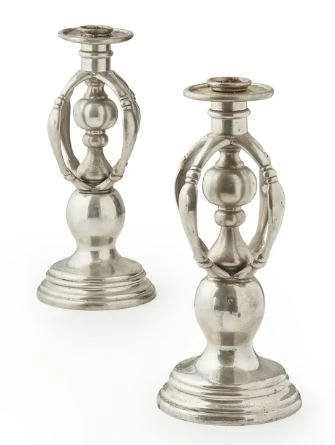 If you are interested in antique and collectible pewter, it is important to know how to research these pieces. Pewter is a metal alloy that has been used for centuries to create a variety of decorative and functional objects. From tankards and plates to candlesticks and spoons, pewter items can be found in many antique shops and auctions. However, not all pewter pieces are created equal, and it takes some knowledge and research to determine the value and authenticity of a particular piece. In this guide, we will explore some of the things to look for when researching antique and collectible pewter.
If you are interested in antique and collectible pewter, it is important to know how to research these pieces. Pewter is a metal alloy that has been used for centuries to create a variety of decorative and functional objects. From tankards and plates to candlesticks and spoons, pewter items can be found in many antique shops and auctions. However, not all pewter pieces are created equal, and it takes some knowledge and research to determine the value and authenticity of a particular piece. In this guide, we will explore some of the things to look for when researching antique and collectible pewter.
History of Pewter
Pewter has been used since the Roman times, but it was during the Middle Ages that it became a popular material for tableware and other decorative items. Pewter is made primarily from tin, with small amounts of other metals, such as copper and antimony, added to give it strength and durability. Pewter was often used as a less expensive alternative to silver, which was a more precious metal.
During the 18th and 19th centuries, pewter became less popular as silver became more affordable. However, there was a revival of interest in pewter during the Arts and Crafts movement in the late 19th and early 20th centuries, and today it is still a popular collectible.
How to Identify Pewter
When researching pewter, the first step is to identify whether a piece is actually pewter. Pewter has a dull grey appearance and is softer than other metals, such as silver or copper. It is also heavier than it appears, due to its density. Pewter is not magnetic, so if a magnet is attracted to a piece, it is not pewter.
There are also a number of marks and symbols that can help identify pewter. Many pewter pieces have the maker's mark stamped on the bottom or side of the piece. This mark may include the maker's name, initials, or a symbol. It is important to note that not all pewter pieces will have a maker's mark, as this was not always a common practice.
How to Determine Age and Value
Once you have identified a piece as pewter, the next step is to determine its age and value. The age of a pewter piece can be determined by the style and design, as well as any marks or symbols that may be present. For example, pewter pieces from the 17th century are often simple in design and may have a crude maker's mark, while pieces from the 18th and 19th centuries may have more elaborate designs and marks.
The value of a pewter piece is determined by a number of factors, including its age, rarity, condition, and provenance. Pewter pieces that are rare or in excellent condition can command high prices, especially if they have a known history or provenance. It is also important to consider the current market demand for pewter, as trends can change over time.
Researching Pewter Online
One of the easiest ways to research pewter is to use the internet. There are many websites and resources dedicated to antique and collectible pewter, including auction sites, dealer websites, and online forums. These resources can help you identify makers, dates, and values of pewter pieces. It is important to use multiple sources when researching, as not all information found online is accurate.
When using online resources, it is important to be cautious when purchasing pewter online. It is always best to purchase from a reputable dealer or auction house, as they can provide guarantees of authenticity and condition. Additionally, be sure to carefully examine photographs and descriptions of the piece before making a purchase, as some damage or wear may not be apparent in the images.
Visiting Antique Shops and Auction Houses
Another way to research pewter is to visit antique shops and auction houses in person. This allows you to see and handle the pieces up close, which can give you a better sense of their quality and condition. Additionally, many dealers and auctioneers are experts in their field and can provide valuable information and insights about pewter pieces.
When visiting antique shops and auction houses, be sure to ask questions and take notes about the pieces that interest you. Take photographs of the pieces, including any marks or symbols, to reference later. It is also a good idea to establish a relationship with a dealer or auctioneer who specializes in pewter, as they can keep you informed about new acquisitions and upcoming auctions.
Collecting Pewter
Collecting pewter can be a rewarding hobby, as it allows you to appreciate the craftsmanship and history of these pieces. When collecting pewter, it is important to focus on pieces that you find interesting or beautiful, rather than simply collecting for investment purposes. Additionally, it is important to purchase pieces that are in good condition and to care for them properly to prevent damage and deterioration.
Caring for Pewter
To care for pewter, it is important to avoid using harsh chemicals or abrasive materials that can scratch or damage the surface. Instead, use a soft cloth or sponge and a mild soap solution to gently clean the pewter. Avoid using silver polish or other metal cleaners, as these can be too harsh for pewter.
It is also important to store pewter pieces properly, to prevent damage and discoloration. Store pewter pieces in a dry, cool place, away from direct sunlight or sources of heat. If possible, wrap the pieces in acid-free tissue paper or cloth to protect them from dust and scratches.
Conclusion
Antique and collectible pewter can be a fascinating and rewarding area of collecting. With a little knowledge and research, you can identify and value pewter pieces, and appreciate their history and craftsmanship. Whether you are a serious collector or simply appreciate the beauty of these pieces, pewter is a material that has stood the test of time and continues to be appreciated today.
Unlock the true value of your collection with our comprehensive research guides from identifying makers' marks to appraising all kinds of antiques and collectibles, including items featured in this article.
Our up-to-date information will give you an accurate understanding of your items' worth. Don't miss out on this valuable resource - visit our research tools today!
In addition to some examples shown below on this page, you can also search our price guide for your own treasures.
Examples of related items from our Price Guides
-
 ASSORTED PEWTER AND LIGHTING, 51 ITEMSAs
[more like this]
ASSORTED PEWTER AND LIGHTING, 51 ITEMSAs
[more like this]
-
 (3 PC) CIPOLLA PEWTER TABLEWARE GROUPING
[more like this]
(3 PC) CIPOLLA PEWTER TABLEWARE GROUPING
[more like this]
-
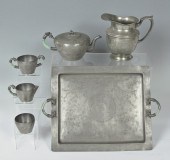 CHINESE PEWTER TEA SET WITH JADE? HANDLE
[more like this]
CHINESE PEWTER TEA SET WITH JADE? HANDLE
[more like this]
-
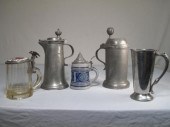 Lot of five German beer steins. Includes
[more like this]
Lot of five German beer steins. Includes
[more like this]
-
 Pewter Group incl. Teapots, Candlesticks
[more like this]
Pewter Group incl. Teapots, Candlesticks
[more like this]
-
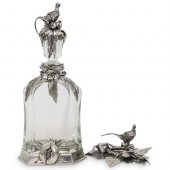 (2 PC) CIPOLLA PEWTER DECANTER & CANDLE
[more like this]
(2 PC) CIPOLLA PEWTER DECANTER & CANDLE
[more like this]
-
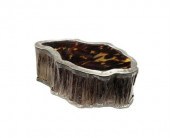 Unusual Chinese tortoiseshell, pewter an
[more like this]
Unusual Chinese tortoiseshell, pewter an
[more like this]
-
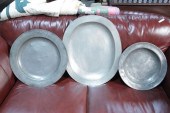 THREE PEWTER DISHES. One single reeded r
[more like this]
THREE PEWTER DISHES. One single reeded r
[more like this]
-
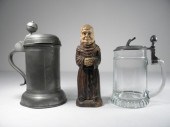 Lot of two German tankards and a carved
[more like this]
Lot of two German tankards and a carved
[more like this]
-
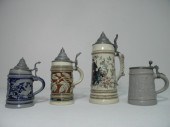 Lot of four German porcelain and stonewa
[more like this]
Lot of four German porcelain and stonewa
[more like this]
-
 Pewter and Copper table items to include
[more like this]
Pewter and Copper table items to include
[more like this]
-
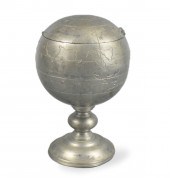 CHINESE PEWTER TELLURIAN SHAPED WINE WAR
[more like this]
CHINESE PEWTER TELLURIAN SHAPED WINE WAR
[more like this]
There are many more auction results available to our members...





